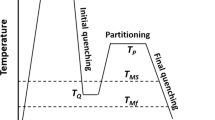Conclusions
-
1.
Tempering of quenched steel 20KhN4 FA at 200°C results in the best combination of mechanical properties (σb = 150 kg/mm2, σT ∼ 120 kg/mm2, δ=12%, ι∼58%,a n=9.0 kg-m/cm2) in combination with high resistance to brittle failure (Tcr=−80°C).
-
2.
The increase of the ductile-to-brittle transition temperature after tempering at 400–600°C is due to the heterogeneity of the structure associated with the precipitation of carbides.
Similar content being viewed by others
Literature cited
B. A. Drozdovskii and Ya. B. Fridman, Effect of Cracks on the Mechanical Properties of Structural Steels [in Russian], Metallurgizdat, Moscow (1960).
P. O. Pashkov and V. A. Bratukhina, Fiz. Metal. Metalloved.,3, No. 1 (1953).
M. P. Arbuzov, Voprosy Fiziki Metallov i Metallovedenie, No. 3 (1952).
Additional information
Translated from Metallovedenie i Termicheskaya Obrabotka Metallov, No. 10, pp. 56–58, October, 1971.
Rights and permissions
About this article
Cite this article
Beilinova, T.A., Yankovskii, V.M. & Gordeeva, L.I. Structure and properties of steel 20KhN4FA after tempering. Met Sci Heat Treat 13, 861–863 (1971). https://doi.org/10.1007/BF00713825
Issue Date:
DOI: https://doi.org/10.1007/BF00713825




